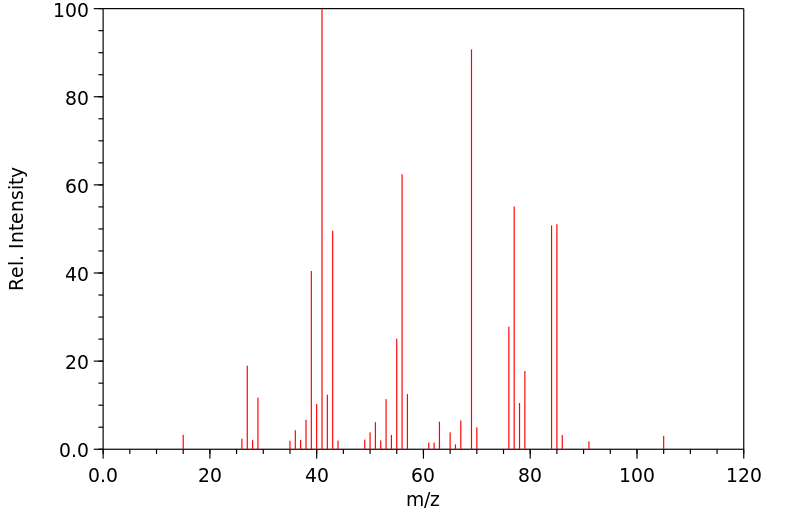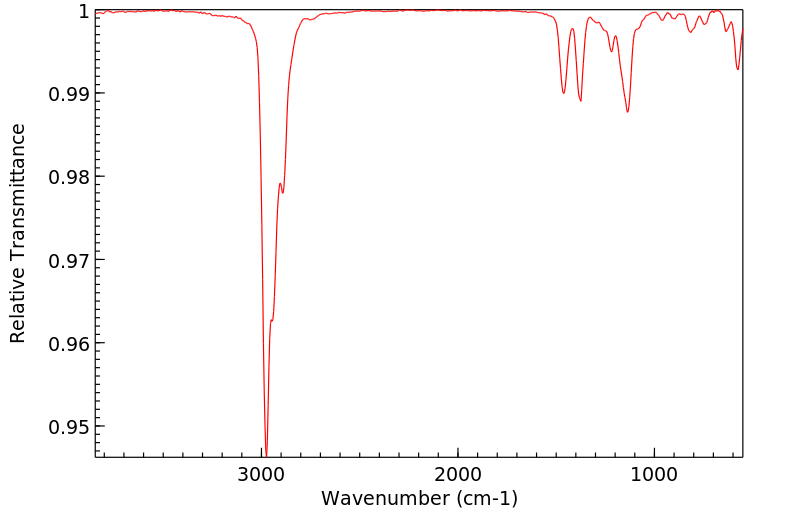2-chloro-2-methylpentane | 4325-48-8
中文名称
——
中文别名
——
英文名称
2-chloro-2-methylpentane
英文别名
2-Chlor-2-methyl-pentan;Dimethylpropylcarbinchlorid;2-methyl-2-chloropentane
CAS
4325-48-8
化学式
C6H13Cl
mdl
MFCD00060777
分子量
120.622
InChiKey
NXXHAWKBICGUCK-UHFFFAOYSA-N
BEILSTEIN
——
EINECS
——
-
物化性质
-
计算性质
-
ADMET
-
安全信息
-
SDS
-
制备方法与用途
-
上下游信息
-
文献信息
-
表征谱图
-
同类化合物
-
相关功能分类
-
相关结构分类
物化性质
-
熔点:-35.1°C (estimate)
-
沸点:111°C
-
密度:0,86 g/cm3
-
溶解度:氯仿(可溶)、DMSO(少量溶解)、乙酸乙酯(少量溶解)、甲醇(少量溶解)
-
保留指数:766.54;767
-
稳定性/保质期:
在常温常压下,该物质保持稳定。
计算性质
-
辛醇/水分配系数(LogP):2.7
-
重原子数:7
-
可旋转键数:2
-
环数:0.0
-
sp3杂化的碳原子比例:1.0
-
拓扑面积:0
-
氢给体数:0
-
氢受体数:0
安全信息
-
危险等级:3
-
安全说明:S16,S26,S36/37/39
-
危险类别码:R10,R36/37/38,R43
-
海关编码:2903199000
-
包装等级:III
-
危险品运输编号:UN 1993
-
储存条件:请将药物存放在避光、通风干燥的地方,并密封保存。
SDS
反应信息
-
作为反应物:描述:参考文献:名称:Klingstedt, Chemische Berichte, 1925, vol. 58, p. 2368摘要:DOI:
-
作为产物:描述:参考文献:名称:DE259192摘要:公开号:
文献信息
-
Use of metal-accumulating plants for implementing chemical reactions
-
[EN] PYRIMIDINE COMPOUNDS AND THEIR USE AS PESTICIDES<br/>[FR] COMPOSES DE PYRIMIDINE ET UTILISATION DE CEUX-CI COMME PESTICIDES申请人:SUMITOMO CHEMICAL CO公开号:WO2003076415A1公开(公告)日:2003-09-18The present invention relates to a pyrimidine compound of formula (1): wherein R1 is C3-C7 alkynyl; R2 is hydrogen, halogen, or C¿1?-C3 alkyl; and R?3 is C¿1-C8 alkyl that may be substituted with halogen or C1-C3 alkoxy, or C3-C6 cycloalkyl (that may be substituted with halogen or C1-C3 alkyl) C1-C3 alkyl; a pesticidal composition comprising the pyrimidine compound as an active ingredient; and a method for controlling pests comprising applying the pyrimidine compound to pests or habitats of pests.
-
Synthesis of Hindered<i>t</i>-Alkyl Ethers作者:Hiromitsu Masada、Tadahide SakajiriDOI:10.1246/bcsj.51.866日期:1978.3Di-t-butyl ether was prepared in 6–73% yields by the reactions of t-butyl halide with Ag2CO3, Ag2O, HgO, ZnO, ZnCO3, PbO2, Cu2(CO3)(OH)2, and Tl2O3 at 20–65 °C in hydrocarbons under nitrogen. Similar reactions gave seven new hindered di-t-alkyl ethers: di-t-pentyl ether, bis(1,1-dimethylbutyl) ether, bis(1-ethyl-1-methylpropyl) ether, bis(1,1-dimethylpentyl) ether, bis(1-ethyl-1-methylbutyl) ether, bis(1,1-diethylpropyl) ether, and bis(1,1-dimethylhexyl) ether. The yield of di-t-alkyl ether decreased as the t-alkyl group became bulky. A slight difference in the skeletal structure of the t-alkyl halide markedly influences the substitution. The reaction pathways are elucidated on the basis of the experimental results.
-
Competitive 1,2- and 1,3-hydride shifts and the possible role of protonated and methylated cyclopropane intermediates in alkyl group rearrangements accompanying the thermal decomposition of saturated alkyl chloroformates in the liquid phase作者:Harry R. Hudson、Andrew J. Koplick、David J. PoultonDOI:10.1039/p29790000057日期:——that the thermal decomposition of ethyl chloroformate in the liquid phase yields chloroethane without rearrangement of the ethyl group. Longer chain primary alkyl chloroformates yield rearrangement products which can be rationalised on the basis of two initial competitive pathways, one involving a 1,2-hydride shift and the other the formation of a corner-protonated cyclopropane intermediate. The latter氘标记表明,液相中的氯甲酸乙酯热分解会生成氯乙烷,而不会发生乙基重排。较长链的伯烷基氯甲酸酯可产生重排产物,可根据两个初始竞争途径进行合理化,一个途径涉及1,2-氢化物转移,另一个涉及角质子化的环丙烷中间体的形成。后者可能被捕获以产生重排的伯烷基氯(在正丙基情况下质子会发生相当大的扰乱)或在高级烷基中产生1,3-氢化物移位(Bu n(例如,正戊基,3-甲基丁基,正辛基),其中可以重排至s-或t-烷基阳离子。除非这些中的第二个导致叔烷基阳离子,否则连续的1,2-氢化物转移意义不大。3,3-二甲基丁基基团提供了衍生自连续的氢和甲基的1,2-移位和1,2-叔丁基移位的产物,据认为这涉及甲基化的环丙烷的中间体。直接衍生自s-烷基氯甲酸酯的s-烷基阳离子显示出比通过伯烷基氯甲酸酯重排衍生的s-烷基阳离子更少的重排趋势。提出的证据表明,烷-1-烯是由伯烷基氯甲酸酯通过碳阳离子中间体形成的,其中发生了1
-
Transition metal compound, polymerization-initiator system comprising the same, and process for producing polymer申请人:Uemura Makoto公开号:US20070270521A1公开(公告)日:2007-11-22A transition metal compound represented by the formula, [(CpR 1 m )(CO) 2 M 1 ][M 2 (CO) 2 (CpR 2 n )], wherein Cp is a cyclopentadienyl ring, R 1 and R 2 are independently of each other a hydrocarbyl group having 1 to 20 carbon atoms, and each of at least one R 1 and at least one R 2 is a hydrocarbyl group having 5 to 20 carbon atoms, m and n are independently of each other an integer of 1 to 5, and M 1 and M 2 are independently of each other a transition metal atom of the group 8 in the periodic table of elements; a polymerization-initiator system comprising said transition metal compound; and a process for producing a polymer in the presence of the polymerization-initiator system.
表征谱图
-
氢谱1HNMR
-
质谱MS
-
碳谱13CNMR
-
红外IR
-
拉曼Raman
-
峰位数据
-
峰位匹配
-
表征信息
同类化合物
顺式1,4-二氯-2-甲基-2-丁烯
顺式1,1,1,5-四氯-4-甲基-3-戊烯
顺式-7-甲基环庚-2-烯基氯
顺式-4-甲基环庚-2-烯基氯
顺式-1-氨基-4-氯-2-丁烯
顺式-1,4-二氯-2-丁烯
顺-6-氯-2-己烯
顺-4-氯-2-丁烯胺盐酸盐
锡烷,二(4-氯丁基)羰基-
锡烷,三氯(2-乙烯基壬基)-
重氮乙酰氯
辛基癸基二甲基氯化铵
聚乙烯胺
羟肟基乙酰氯
磷亚胺三氯化,[1,2,2,2-四氯-1-(三氯甲基)乙基]-
硫代氯甲酸-O-辛酯
癸醛,2,2-二氯-
甲醛与氨和氯乙烷的聚合物
甲基(2E)-2-(3-氯-2-丁烷亚基)肼羧酸酯
环己烷,(氯甲基)-
环丙烷,2-丁基-1-氯-1-(1-戊炔基)-,顺-
环丙烷,1,2-二溴-3,3-二氯-1,2-二丙基-,反-
环丙烷,1,1-二溴-2,3-二氯-2,3-二乙基-,反-
环丙烷,1,1-二氯-3-(氯甲基)-2,2-二甲基-
环丙烷,1,1,2,3-四氯-2,3-二甲基-,反-
环丙基甲基氯
环丁基氯
特比萘芬杂质17
溴代二氯丁烷
油酰氯
油酰氯
水合2-氯乙醛
氯螺戊烷
氯磺酸-(2,3-二氯丙酯)
氯甲醇
氯甲氧基
氯甲基自由基
氯甲基环丁烷
氯甲基氯磺酸酯
氯甲基二氯甲基醚
氯甲基(甲基)次磷酰氯
氯环辛烷
氯环癸烷
氯环庚烷
氯环丙烷
氯十七烷
氯化链烷烃
氯化环十二烷
氯化新戊烷
氯代环戊烷








